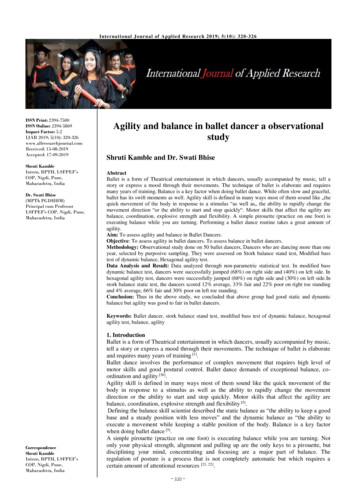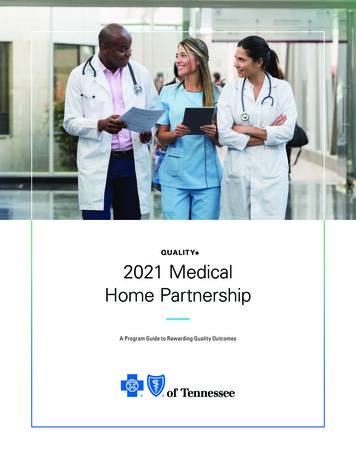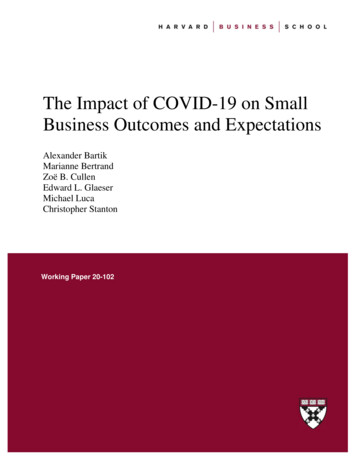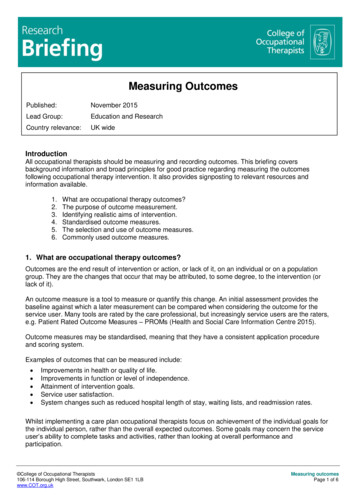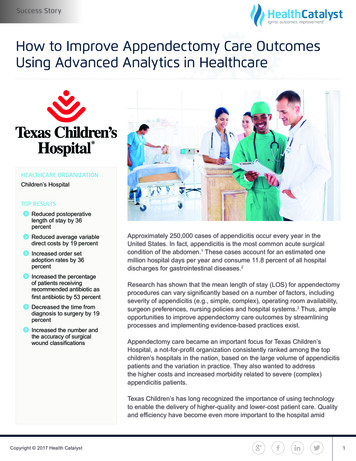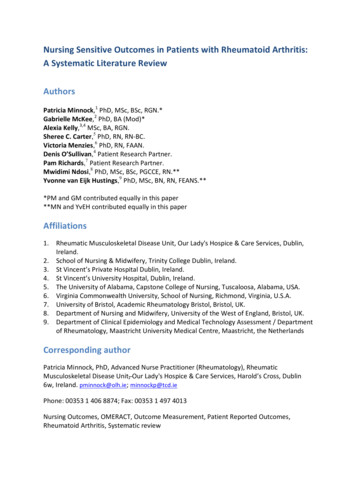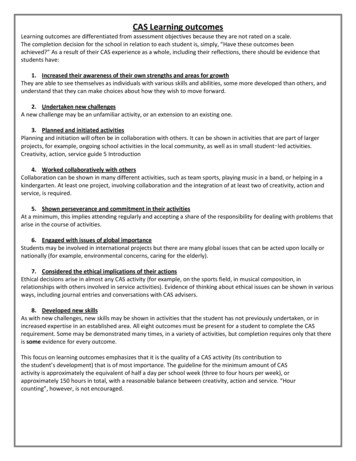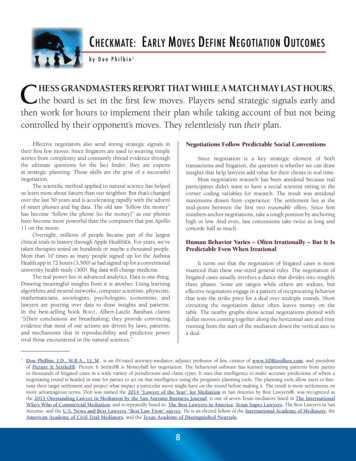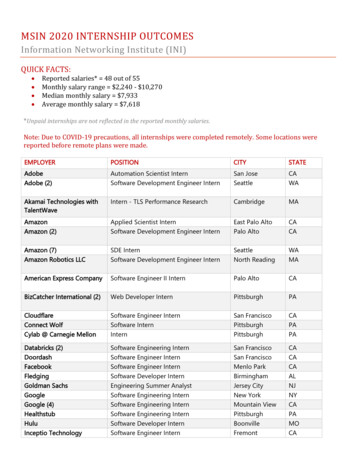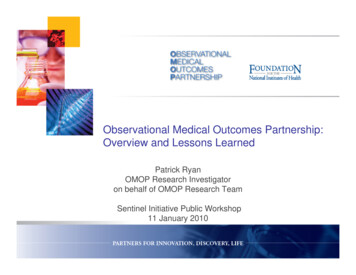
Transcription
Observational Medical Outcomes Partnership:Overview and Lessons LearnedPatrick RyanOMOP Research Investigatoron behalf of OMOP Research TeamSentinel Initiative Public Workshop11 January 2010
Observational Medical OutcomesPartnershipA public-private partnership to serve the public health by testingwhether multi-source observational data can improve our abilityto assess drug safety and benefits. GovernanceData MethodsTechnology Assess the appropriatetechnology and datainfrastructure required forsystematic monitoring ofobservational dataDevelop and test thefeasibility and performance ofthe analysis methodsEvaluate required governancestructuresPage 2
Outstanding questions for active surveillanceGovernanceWhat are the keys to asuccessful publicprivate partnership?DataWhich types of data? administrativeclaims, electronic health recordsWhat are viable data accessmodels:- centralized?- distributed?Which sources? healthcareproviders, insurers, data aggregatorsPerformanceHow to maintaincollaborationsand engageresearchcommunity?ArchitectureWhat are appropriateanalyses for:Feasibility- hypothesis generating?- hypothesis strengthening?MethodsWhat is the appropriateinfrastructure:- hardware?- software?- processes?- policies?TechnologyWhat are bestpractices forprotectingdata?Page 3
Breadth and diversity of OMOPresearch communityOMOP’s research community requires active participation fromall key stakeholders, including government, academia, industry,health care organizations, and patient groups.GovernanceDataMethodsTechnologyGovernance 10 Executive Board members, chaired byFDA and managed by Foundation for NIH 21 Advisory Board members Led by 5 research investigators and PMOMethods 17 methods collaboratorsData 6 distributed partners, 5 central databasesTechnology 2 data access models, 7 different systemsarchitectures, including Research LabOver 100 partners collaborating to advance the science of drug safety!Page 4
OMOP Research Phases Phase 1: FEASIBILITY OF DATA INFRASTRUCTURE (Feb – July 2009)– Establish a consistent framework to use across disparate observational datasources– Establish OMOP Research Community Phase 2: FEASIBILITY OF ANALYSES (Aug – Dec 2009)– Develop and test analysis methods within the OMOP Research Lab and otherdata environments– Establish standard data characterization procedures– Implement health outcomes of interest definitions– OMOP to facilitate comparisons across databases Phase 3: PERFORMANCE MEASUREMENTS (Jan – July 2010)– Evaluate performance of methods and data in identifying drug safety issues– OMOP to facilitate comparisons across databases Phase 4: UTILITY OF ANALYSES & PROCESS (July – Dec 2010)– Assess the effectiveness and usefulness of how the results and comparisonscontribute to decision-makingPage 5
OMOP data assessment:Provider willingness for data access modelsOrganizations(n 21)Totalpopulation (m)Centralized model: Provide your dataexternally to load into the Central ResearchCore IT environment7297Federated model: Facilitate OMOPresearchers access to execute queriesdirectly (through firewall)4252Distributed CDM Model: OMOP queriesrun locally by your research staff17470Distributed protocol model: Develop andrun your own queries locally19413Each access model would have access to over 250m lives in aggregate,indicating the FDAAA mandate of 100m persons is achievable under allalternative infrastructures without full participation of potential datasourcesPage 6
Evaluating alternative data access modelsCentralized modelCentralserverstoresdatabases Central systems architecture(network, hardware, software) Data owner provide access to deidentified patient-level data One or more databases storedindependently (no data pooling) Analyses coordinated andconducted by central team across Central responsibility for validity ofdata and analysesDistributed networkCentralcoordinatingcenter Data owner conducts patient-levelanalyses within own systemsarchitecture Central coordinating centermanages protocol development andaggregates summary analysisresults submitted by distributedpartners Distributed partners assumeresponsibility for validity of data andanalysesPage 7
Diversity across OMOP data communityOMOP Extended ConsortiumOMOP Research CoreHumanaRegenstriefResearch LabPartnersHealthCareCentralized dataThomson Reuters GEI3 DrugSafetySDI HealthVADistributed NetworkPage 8
Role of common data model in OMOPAnalysis processSource 1Source 2Source 3Transformation to OMOP common data modelPage 9
Establishing a common data model Developed with broad stakeholder inputDesigned to accommodate disparate types of data (claims and EHRs)Applied successfully across OMOP data age 10
Standardizing terminologies to accommodatedisparate observational data sourcesSystem Organ Class(Level 5)Standardizingconditions:MedDRAMedDRAHigh Level Group Terms(Level 4)MedDRAMedDRAHigh Level Terms(Level 3)MedDRAMedDRAPreferred Terms(Level 2)MedDRAMedDRALow-level Terms(Level 1)MedDRAMedDRASource -CTTop-levelclassification(Level vel 2)SNOMED-CTSNOMED-CTLow-level concepts(Level dizingdrugs:Top-level concepts(Level 4)NDF-RTNDF-RTClassifications(Level 3)NDF-RTNDF-RTExistingDe NovoDerivedMappingIngredients(Level 2)RxNormRxNormLow-level drugs(Level 1)RxNormRxNormExistingDe NovoDerivedSource -4*ICD-9-Proc*ICD-9-Proc*Page 11
Role of common data model in OMOPAnalysis processSource 1Source 2Source 3Transformation to OMOP common data modelAnalysismethodOMOPAnalysisresultsPage 12
Heart of OMOP’s methodological research:Assessing the diversity in analysis methodsDisproportionality analysisProportionalreporting ratioBayesianMulti-itemconfidenceGamma Poissonpropagation neuralShrinkernetworkTemporalpatterndiscoveryOther novelapproaches?OMOP CupExposure-based approachesCohortScreeningIncident userdesignsHighdimensionalpropensityscoringLocal controlMaximizedsequentialprobability ratiotestCase-based uential methodsSelf-controlledcase MOP Methods Library at: http://omop.fnih.org/MethodsLibraryPage 13
OMOP Methods LibraryMethod 1OMOP Methods LibraryMethod 2Method 3Method 4 Standardized procedures arebeing developed to analyzeany drug and any condition All programs being madepublicly available to promotetransparency and consistencyin research Methods will be evaluated inOMOP research againstspecific test case drugs andHealth Outcomes of InterestOMOP Methods Library at: http://omop.fnih.org/MethodsLibraryPage 14
OMOP research experiment workflowOMOP Extended ConsortiumOMOP Methods LibraryOMOPResearchResearch CoreOMOPCoreMethod 1Method 2Method 3Method earchlabLabCommon Data ModelTesting in each source:-accumulating over time-against the entire datasetTesting in each source:-accumulating over time-against the entire datasetHealth Outcomes of Interest1. Angioedema2. Aplastic Anemia3. Acute Liver Injury4. Bleeding5. GI Ulcer Hospitalization6. Hip Fracture7. Hospitalization8. Myocardial Infarction9. Mortality after MI10. Renal FailureDrugs1. ACE Inhibitors2. Amphotericin B3. Antibiotics4. Antiepileptics5. Benzodiazapines6. Beta blockers7. Bisphosphonates8. Tricyclic antidepressants9. Typical antipsychotics10. WarfarinNon-specified conditions-All outcomes in conditionterminology-‘Labeled events’ as reference-Warning-Precautions-Adverse Reactions-Postmarketing ExperiencePage 15
Contact informationPatrick RyanResearch InvestigatorPatrick.b.ryan@gsk.comThomas ScarnecchiaExecutive Directortscarnecchia@fnih.orgEmily WelebobSenior Program Manager, Researchewelebob@fnih.orgOMOP website: http://omop.fnih.orgOMOP Cup website: http://omopcup.orwik.comPage 16
BackupsPage 17
Partnership StructureGovernance Provided by an Executive BoardScientific and Informatics advisory boards inform decisionsFNIH BoardKey Design Elements:Scientific Advisory BoardExecutive Board1. Governance and Oversight2. Research LeadershipHealthcare InformaticsAdvisory BoardExecutive Director3. Program Management4. Partners & CollaboratorsProgram ManagementOfficePrincipal InvestigatorsInfrastructure teamKeyOversightDedicatedResearch Team System integrator team, EDand PMO oversight Industry, academic and otherexternal resourcesPage 18
Executive BoardA multi-stakeholder group, the OMOP Executive Board overseesthe operation of the Partnership.Janet Woodcock, MDDirector, Center for Drug Evaluation and Research,Food and Drug AdministrationChair, Observational Medical Outcomes PartnershipExecutive BoardRebecca BurkholderVice President of Health Policy, The NationalConsumers LeagueSherine Gabriel, MD, MScProfessor of Medicine and Epidemiology, The MayoClinicCynthia Gilman, JDSpecial Assistant to the President for Advancement ofCancer Research and Collaborative Partnerships,Henry Jackson FoundationJesse L. Goodman, MD, MPHChief Scientist and Deputy Commissioner for Scienceand Public Health (acting),Food and Drug AdministrationRichard Platt, MD, MScProfessor and Chair of the Department ofAmbulatory Care and Prevention, Harvard MedicalSchool and Harvard Pilgrim Health CareStephen Spielberg, MD, PhDMarion Merrell Dow Chair in PediatricPharmocogenomics, Children’s Mercy Hospital andDean Emeritus, Dartmouth Medical SchoolBrian Strom, MD, MPHGeorge S. Pepper Professor of Public Health andPreventive Medicine; Professor of Biostatistics andEpidemiology, Medicine, and Pharmacology; Chair,Department of Biostatistics and Epidemiology;Director, Center for Clinical Epidemiology andBiostatistics; Vice Dean for Institutional Affairs,University of Pennsylvania School of MedicineSenior Advisor to the Provost for Global HealthInitiatives, University of PennsylvaniaDavid Wheadon, MDSenior Vice President, Pharmaceutical Researchand Manufacturers of America (PhRMA)Ronald L. Krall, MDFormer Senior Vice President and Chief Medical Officer,GlaxoSmithKlinePage 19
Research InvestigatorsThe Principal Investigators (PIs) are the lead scientists for theOMOP project and guide and participate in the research acrossall four project phasesMarc Overhage, MD, PhD: Director, Medical Informatics and Research Scientist,Regenstrief Institute, Inc.; Regenstrief Professor of Medical Informatics, IndianaUniversity School of Medicine,CEO; President of the Indiana Health InformationExchangePaul Stang, PhD, FISPE: Senior Director, Epidemiology, Johnson & JohnsonPharmaceutical Research and DevelopmentAbraham G. Hartzema PharmD, MSPH, PhD, FISPE: Professor and EminentScholar, Pharmaceutical Outcomes & Policy, Perry A. Foote Chair in HealthOutcomes Research, University of Florida College of PharmacyJudy Racoosin, MD, MPH: Sentinel Initiative Scientific Lead, US Food and DrugAdministrationPatrick Ryan: Manager Drug Development Sciences, GlaxoSmithKline R&DOMOP Co-InvestigatorPage 20
Foundation for the NIH Program StaffThomas Scarnecchia, MSExecutive Director, OMOPEmily Welebob, RN, MSSenior Program Manager, ResearchChristian Reich, MD, PhDSenior Program Manager, TechnologyPage 21
OMOP Statistics and Programming TeamDavid Madigan, PhDColumbia UniversityOMOP Methods LeadIvan Zorych, PhDColumbia UniversityCortney HayflingerHayflinger Analytic ServicesMark KhayterEphir, Inc.Carlos AlzolaData InsightsEmmanuel AngelAngelic ProductionsReed Georgeetera solutionsEric LantzUniversity of Wisconsin-MadisonRon ManthaEphir, Inc.Page 22
Advisory BoardsA Scientific Advisory Board (SAB) willprovide independent review of and expertinput into the scientific aspects of OMOP’sactivities.A Health Informatics Advisory Board (HIAB) willprovide independent review and expert input intothe OMOP’s technology governance and projectrequirements related to privacy and security,terminology and coding, data and data models. Elizabeth Andrews, RTI Health Solutions Col. Kevin Abbott Andrew Bate, Pfizer Jeff Brown, Harvard Medical School Jesse Berlin, Johnson & Johnson Stan Huff, Intermountain Healthcare Robert Davis, Kaiser Permanente Diane MacKinnon, IBM (retired) Steve Findlay, Consumer Union Ken Mandl, Harvard University Sean Hennessy, University of Pennsylvania Mike Katz, FDA patient representativeClem McDonald, National Library ofMedicine Allen Mitchell, Boston University David Memel, Klaipeda Consulting David Page, University of Wisconsin Mitra Rocca, FDA Ken Rothman, RTI Health Solutions Joy Pritts, Georgetown University Judy Staffa, FDA Alec Walker, WHISCONRob Thwaites, United BioSourceCorporationPage 23
Research Collaborators:Data and Infrastructureas of 11/12/09OrganizationTeam LeaderActivityComputer Sciences CorporationDan FoltzResearch LabDepartment of Veterans Affairs Center for Medication SafetyFran Cunningham, PharmDDistributed PartnerGE HealthcareMichael Lieberman, MDResearch Labi3 Drug SafetyArnold Chan, M.D., Sc.D.Distributed PartnerIndiana University - Regenstrief InstituteJ. Marc Overhage, MD, PhDDistributed PartnerPartners HealthCare SystemShawn Murphy, MD, PhDDistributed PartnerProSanos CorporationStephanie ReisingerSimulated DataSDI HealthGregory Hess, MD, MBA, MScDistributed PartnerThomson ReutersStella Chang, MPHResearch LabUniversity of Miami-Humana Health Services Research Center Vinit Nair, BS Pharm., MS, RPhDistributed PartnerPage 24
Research Collaborators:Methodsas of 11/12/09OrganizationTeam LeaderActivityColumbia UniversityDavid Madigan, PhDMethods LeadEli Lilly and CompanyKarin L. BenoitMethods PartnerGPRD Group of the MHRAJohn Parkinson, BSc, PhDMethods PartnerHarvard Pilgrim Health Care InstituteLingling Li, PhDMethods PartnerIndiana University - Regenstrief InstituteSiu L. Hui, PhDMethods PartnerM Alan Brookhart, PhD and SAS InstituteM. Alan Brookhart, PhDMethods PartnerMerck Research LaboratoriesDr. A. Lawrence GouldMethods PartnerProSanos CorporationStephanie ReisingerMethods PartnerRisk Benefit Statistics LLCRobert L. (Bob) Obenchain, PhD, FASA Methods PartnerRTI InternationalSuzanne L. West, MPH, PhDHOI LibrarySlone Epidemiology Center at Boston UniversityDavid Kaufman, ScDMethods PartnerUnited BioSource CorporationMatthew W. Reynolds, PhDHOI LibraryUniversity of North Carolina at Chapel HillStacie DusetzinaHOI LibraryUniversity of UtahBrian Sauer, PhDMethods PartnerUniversity of Wisconsin-MadisonDavid Page, PhDMethods PartnerUppsala Monitoring CenterNiklas Norén, PhDMethods PartnerPage 25
Sentinel Initiative Public WorkshopMonday, January 11, 2010
Apr 05, 2012 · Computer Sciences Corporation Dan Foltz Research Lab Department of Veterans Affairs Center for Medication Safety Fran Cunningham, PharmD Distributed Partner GE Healthcare Mi
